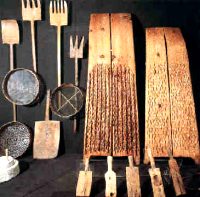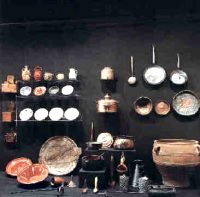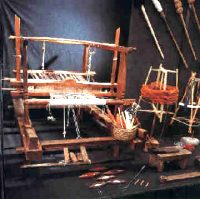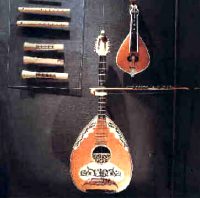The Museum of Cretan Ethnology in
Voroi (GR: Βώροι) is an institution of the
Cultural Association of the Province of Messara. It was erected between 1977-1982 and opened its doors to the public in 1988. Its construction was sponsored by the Ministry of Culture and by members and friends of the Association.
The Museum has 20.000 visitors per year.
The
research department of the Museum has been engaged in various research activities since 1980. It functions as a coordinating body for the study of the Cretan ecosystems, covering the period from 1000 AD to our days.
The
exhibited objects in the Museum come from all over Crete. These objects show that the folk culture of Crete is characterized by an amalgam of influences in which
Minoan (2000-1000 BC),
Archaic (1000-500 BC) and
Byzantine models prevail, especially in agriculture, stock breeding, pottery and basketry.
Through 700 years of occupation, the Cretan people never surrendered to foreign models. The last period of vassalage was particularly harsh (second Turkish occupation 1669-1898), which is why material evidence of preceding centuries is very scarce.
Most of the objects exhibited in the Museum date from the period of Turkish occupation. Their stark simplicity reflects the economic degradation. However the Byzantine tradition is preserved, wherever possible, as in the designs of traditional woven fabrics, in wood caving, architecture, and of course in music, dancing, singing and language.
Categories of exhibits in the Museum of Cretan Ethnology
Diet
Every day life was hazardous for the people in Crete, who remained in bondage some 700 years. In order to supplement their daily dietary needs, the Cretan were obliged to gather natural products.
Among the exhibits related to the diet, are agricultural tools, tools for herding and shearing and cooking vessels.
Architecture
Cretan buildings are small and simple in form, conforming to architectural norms of Byzantine provenance, which have evolved slowly since 1205 and display only negligible Venetian influences.
Weaving
Among the exhibits there are a loom room, tools for preparing raw materials, cloths, blankets and covers.
Production - Trade
Manufacturing in Crete was confined to essential items. Nevertheless, the artisans distinguished their products according to function, by adding decorative elements.
In the Museum are exhibited some important representative samples of basketry, pottery, metalworking and as well as a carpenter's, packsaddle maker's and shoemaker's work bench and tools.
Transportation
The Venetian conquerors (1205-1640) and then the Turks (1640-1900) forbade the Cretans from practicing sea transport and trade, and systematically neglected developing a road network on the island. They were afraid that such an infrastructure, as well as means of transport, would facilitate the successive insurrections of the populace.
The usual form of transportation for the ordinary folk was the pack animal. Cereals were loaded in large woollen or cotton sacks, and other solid produce in panniers. Liquids were transported in goatskin flasks.
Morals and mores
Human society transforms certain aspects of personal survival into symbols, which are expressed through speech, gesture or an object. They are of common acceptance and are essential to the maintenance of societal equilibrium.
There are relatively few ceremonial vessels in Crete, perhaps because its traditional society is one of the best balanced in Greece.
Social organization
The culture of Crete has been determined by the peculiarity of its anthropological reserves. For 700 years (period of foreign occupation of the island) there were no schools, while the Administration and Judiciary were organized by the conquerors. The Cretan people were isolated and a classless, particularly well-balanced liberal society, governed by "unwritten laws".
Among the exhibits are some sacerdotal vestments, ecclesiastical objects, musical instruments and weapons.

Threshing sledge, Hand mill

Cooking vessels

Loom - Loom parts and tools

Shoe-maker's bench and tools

Pipes, Cretan Lyra, Laouto